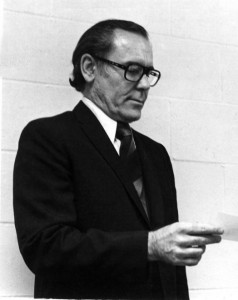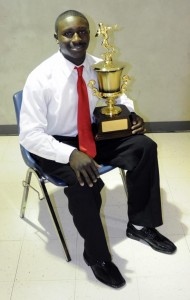









Gallery |
Starting from ScratchSeptember 13, 2012 By Kelly Dyer Today, at the venerable age of 90, Professor Emeritus Dr. Bob Fonda cheerfully admits that he has seen many milestones over the years at Minnesota State Mankato. One of those would most certainly be celebrating the 40th anniversary of the Dental Hygiene Program, which Fonda started almost single-handedly in 1969.  Dr. Robert Fonda will be at the Department of Dental Hygiene’s 40th Anniversary Reunion on Saturday, September 29 in the Centennial Student Union Ballroom. Although the program has turned out countless well-qualified dental hygiene graduates over the past four decades, it got off to what Fonda characterizes as something of a “rough start.” That may be a bit of an understatement. The genesis of the program came about like this: After spending four years in the Navy, Fonda practiced dentistry for 23 years in the small town of Rockwell City, Iowa. Unfortunately, spending that many years hunching over patients as he worked contributed to significant back problems, and in 1969, Fonda began to think about finding a new job in the dental field. At about that same time, Minnesota State Mankato was investigating the possibility of starting a professional two-year dental hygiene program. Fonda met with college administrators and was offered a job. He accepted and agreed to come to campus to start putting the program together late in 1969. What Fonda discovered once he arrived on campus was nothing. No books had been ordered. He didn’t have a classroom, a secretary or even a telephone. The college lacked a physical clinic in which students could receive practical instruction, and in fact, there wasn’t even a curriculum outline for the classes that were scheduled to begin the following spring. Asked now if he realized what he was getting himself into all those years ago, Fonda chuckles. “No, not really,” he says. “I thought I knew but as in many cases, after you get there and sign the contracts and so on, you discover that there are other things that you are going to have to do…that weren’t maybe exactly the way you want to have them, but you just take the ball and run.”  The history of the Dental Hygiene Program — and Dr. Fonda’s role in it — is documented in a new book from the department. Fonda rolled up his sleeves and got to work. The first order of business was to design a program and curriculum that would meet the accreditation standards of the American Dental Association. He spent countless hours doing that. He also began to interview and hire professional staff who could then teach to those standards. That done, Fonda turned his attention to another pressing problem: The University had purchased a significant amount of used dental equipment from the Veteran’s Administration in anticipation of the new program. As Fonda inspected that equipment, however, he discovered that much of it was hopelessly outdated, damaged or simply not acceptable for use in modern dentistry. That started another scramble to find better equipment. In addition, the physical clinic needed to be constructed, and Fonda spent a great deal of time supervising the construction, all while also sorting out the other details that the new classes would entail. “I had some sleepless nights, let’s put it that way,” he says. “Sometimes I went home at night and just laid there and looked at the ceiling and thought, “Oh my goodness…” Classes began in 1970 on the lower campus, with Fonda and the other instructors traveling from classroom to classroom carrying their tools and textbooks with them. In spite of all of the confusion of those early days, Fonda says he loved teaching. “I liked passing on the information that needed to be passed on to students about dentistry and the various aspects of dentistry, and what kind of background would be required so that you would even be able to perform the duties,” he says. “I loved the student contact. I just thoroughly enjoyed that.” As the program attracted more students, Fonda was also instrumental in finding new ways for the students to interact with the public at large, including working at the Faribault State Hospital, nursing homes, the White Earth Indian Reservation and other areas. Today, Fonda remains delighted with the progress of the program he fathered. Even though he retired in 1986, he remains fiercely proud of its success. “It was a pleasure for me,” he says. “I wouldn’t have missed it for anything.”
POPLAR BLUFF, Mo. — Elbie Fonda set high goals for the 2011 football season. The Caruthersville senior wanted to run for 3,000 yards and lead his team to a state championship. For a shot at one, however, he had to sacrifice the other. “We believed he could do it, but as things progressed, we wanted to take care of his body because we were hoping for 15 games,” Caruthersville coach Nathan Morgan said. “He understood that and did exactly what was needed without question.”  Caruthersville's Elbie Fonda was presented with the Carr Trophy during Wednesday's Poplar Bluff Letter Club's Gridiron Banquet. (Brian Rosener ~ Daily American Republic) Fonda put together an outstanding season, one good enough to earn him the Carr Trophy as the most outstanding player in the SEMO Conference. Fonda was presented the award Wednesday night during the 66th annual Poplar Bluff Letter Club Gridiron Banquet. Fonda is the fourth Caruthersville player to win the award, given annually since 1979, and the first Tigers player since Kendrickus Reed in 2006. Jimmy Jackson, Caruthersville’s first Carr winner in 2003, was an assistant coach for the Tigers this year and held the school record Fonda was shooting for — 2,564 yards rushing. “He’s like an inspiration to me,” Fonda said about Jackson. “Make me want to win it. I wanted to be better than him.” The 5-foot-9, 180-pound running back ran for 1,889 yards and 25 touchdowns during the regular season to lead the conference. He averaged 12.6 yards per carry. He finished with 2,602 yards combined rushing and receiving and scored 33 times to go with 31 tackles on defense. Fonda shared the ball with Darrell Monroe, who also was named to the all-conference backfield. Monroe, a sophomore, ran for 1,019 yards during the regular season. “I had no problem with it,” Fonda said. “I wanted to win.” The Tigers only dropped a 56-55 thriller to Dexter for the conference title and fell to Maplewood-Richmond Heights 36-29 in the Class 2 state quarterfinals to finish 11-2.  Caruthersville's Elbie Fonda looks for running room against Dexter on Friday night in Dexter - Oct. 8, 2011 (David Jenkins ~ Sikeston Standard Democrat) Fonda also won the scoring award in the Central and was one of five Carr finalists announced at the banquet. The other finalists were Sikeston’s James Watson, who rushed for 1,485 yards, Dexter quarterback Cody Stevens, who threw for 1,375 yards and ran for 1,184 yards, Farmington quarterback Chase Busenbark, who threw for 1,698 yards, and Chaffee’s Tyson Estes, who ran for 1,431 yards and earned the scoring award for the South. “All great athletes,” Morgan said. “It was a good class, so Elbie has something to be proud of to win it this year.” The Carr Trophy is named in honor of the late E.E. “Bus” Carr, an early member of the Letter Club who devoted 50 years of service to area athletics serving as an announcer for radio station KWOC in Poplar Bluff. A committee composed of area high school football officials makes the selection. Also presented with awards were Farmington linebacker Roper Garrett with the inaugural Derland Moore Award for the most outstanding defensive player in the conference. Moore, a 14-year NFL player for the New Orleans Saints who was named a second-team SEMO Conference player as a senior at Poplar Bluff, presented the award to Garrett, who had 82 tackles and 45 assists, six sacks and three forced fumbles for the state semifinalist Knights. Jackson assistant coach Bob Sink was presented with the Sam Giambelluca Lifetime Achievement Award for his service to high school athletics over a 41-year career. He announced his retirement during the Jackson football banquet last month. The linemen awards went to Farmington’s Ethan Hennes, Zach Lacey of Dexter and Zach Estes of Scott City. Farmington’s Connor Davault won the scoring award for the North, and Knights coach Todd Vaughn was named coach of the year, along with Dexter’s Aaron Pixley and Hayti’s Justin Peden. © Copyright 2011 Southeast Missourian. All rights reserved. This material may not be published, broadcast, rewritten or redistributed. Other links: YouTube, MaxPreps
Recycling is Fun…Posted on October 12, 2011 by BagsRevolt I had the immense pleasure to meet the founder of Recycling is Fun, Sara Fonda, who has been actively spreading this important message for thirty eight years now. I was obviously interested in visiting their shop, since I was warned it had more than 3000 samples of creative projects to get inspired with.
They work with councils and community groups through out Victoria. One of their projects is the “Home-bound” ready made kits which include materials, patterns, projects and instructions for a wide variety of crafts, tailored to the abilities of the person. It gives the opportunity for a social worker, carer, relative or friend to bring dignity and meaning to people who are unable to or do not want to leave their homes.
This visit has helped me broaden my view on the importance of Recycling. I had previously concentrated mainly on the environmental aspect of it and not so much on the social side of it. From an individual point of view, making something with your hands, expressing yourself in new ways, creatively, while recycling, gives enormous satisfaction. I have been experiencing this in my life for some time now. What is completely new to me is realizing that crafting is a powerful tool to connect with others as well as to make someone´s life a bit more happy!
Recycling is fun for everyone, even men!
PCA’s ‘The Miracle Worker’ communicates Helen Keller’s amazing storyBy Scott Orr, The Daily Courier – 10/11/2011 PRESCOTT – To see “The Miracle Worker” performed live at the Prescott Center for the Performing Arts is to simultaneously suspend disbelief and realize what an effort it is to stage this very physical play effectively. And it is effective. For anyone who has never seen the film or the play, “The Miracle Worker” tells the true story of Helen Keller, a young deaf and blind girl, and her teacher, Annie Sullivan. The story is set in the period immediately following the Civil War, when such children were sometimes believed to be uncontrollable and placed in asylums.  Annie (Joanne Robertson, right) and Helen (Carly Fonda, left) have a breakthrough in communication with the help of a doll. Helen, played by 10-year-old Carly Fonda, is indeed uncontrollable as the play opens. Fonda, acting in a role that has no dialogue, yet sees her on stage for nearly all of the show’s two hours, gives a nuanced performance. “I have learned that you can (convey) words through your facial expressions,” she said. The role requires violent behavior: Helen slaps, kicks and bites people, throws silverware, breaks dishes, and wreaks all manner of other destruction whenever she fails to get her way. Annie (Joanne Robertson) gives as good as she gets, although Robertson said playing the part required a little extra help. “It’s very physical,” she said. “I’m wearing kneepads and I have bruises all over.” Supporting actor Justus Burkitt as Helen’s half-brother, James, steals nearly every scene he’s in, cracking pointed jokes and delivering sarcastic comments to Annie and his father, Captain Keller (Kevin Nissen). He acts as the comic relief in an otherwise very intense show, but his appearances never seem forced or extraneous.  Helen (Carly Fonda) acts up at the breakfast table while Annie (Joanne Robertson) assesses the situation in the Prescott Center for the Arts' production of "The Miracle Worker." Callaghan Howard, Kevin Nissen, Karla Burkitt, Lois Fazio and Justus Burkitt co-star. The show is directed by Catherine Miller Hahn; this is her 60th production. She said it was not easy to stage. “This one is very difficult. There’s lots of pieces to it, lots of scenes, lots of places,” she said. Because of the nature of the theatre (it is a converted church), plays like this one, with multiple sets, require some unusual techniques and staging. “In our theater, we don’t have flies (cables to a tall ceiling) to take things up or down, so you have to figure out a way to move and weave it all,” Hahn said. The set design takes advantage of the open space above the stage, allowing the upstairs spare bedroom in which Annie writes her diary entries to literally be upstairs, above the rest of the house. As usual for this theater, there are unavoidable viewblocks presented by the structural pillars of the church which stand at the front of the stage. It is surprising how frequently these relatively small obstructions block parts of the action at times. If you know the story or have seen the film, you know how it ends. This production also includes a touching “extra” after the end of the play itself.
Pebble Beach war pilot recalls surviving missionsBy DENNIS TAYLOR, Herald Staff Writer, Posted: 09/05/2011 After flying his 50th bombing mission over Europe, Bill Fonda of the United States Army Air Force was rotated back to the U.S. to a base in Greenville, S.C. On the day he got those orders, he briefly considered asking for a transfer to a fighter plane squadron. “I had always wanted to fly fighters, and if I had asked, they might have given me the transfer,” says Fonda, now 91 and living in Pebble Beach. “But I didn’t ask, and they didn’t offer, so I came home. “I’ve always wondered how my life might have turned out if I had pursued that option,” Fonda muses. “I might not have married the woman I married, might not have had the children and grandchildren I have. My whole life might have been very different — assuming I had survived.” His survival, he believes, is the reason he was awarded the Silver Star, for “gallantry in action against the enemy,” along with nine other military medals, for his service in the European Theater during World War II. “It’s not always true — there are exceptions — but my feeling about medals is that you get them for being in the wrong place at the wrong time, and managing to survive,” he says. Read the complete story in The Herald’s print or e-edition of Sept. 4 |